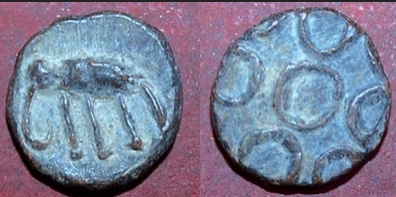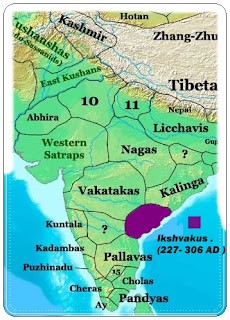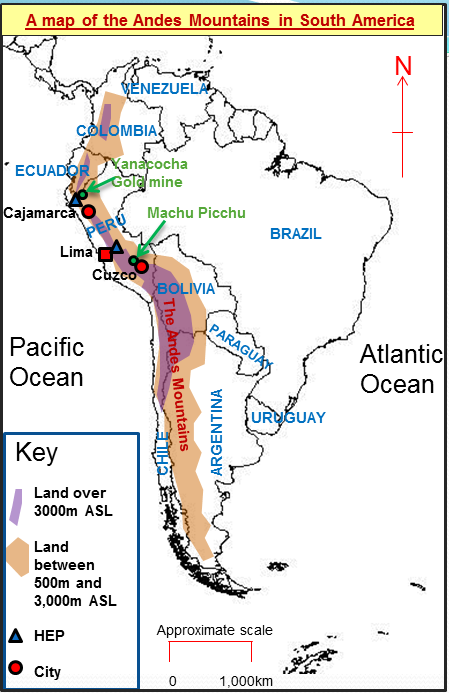Phanigiri
Hoard of lead coins belonging was found in Phanigiri village.
- Etymology – It seems to have derived its name from the shape of a nearby hillock, which appears to be like a snake hood.
- In Sanskrit – Phani means snake and Giri means hillock.
- Location – It lies on the left bank of the Bikkeru rivulet, a tributary of the river Musi in Telangana.
- Discovery – It was 1st discovered & protected during the period of Nizam, was excavated in 1940s by Sri Khaja Mahamad Ahmad.
- It was not a lone site in this zone as there are several Buddhist sites nearby.
Phanigiri village was occupied by pre/proto-historic, early historic, early medieval and Asaf Jahi period inhabitants that had a vibrant life from 1000 BCE to late 18th century CE.
- Coins – A globular pot was unearthed that was filled with lead coins, 3730 in number & the average weight of each coin is 2.3g.
- Other findings – Beads of stone and glass, shell bangle fragments, stucco motifs, broken limestone sculptures, a toy cart wheel, iron nails, and pottery were also found during excavations.
Earlier excavations at Phanigiri had a Mahastupa, apsidal Chaitya Grihas, Viharas, a 24 pillared mandapa and Brahmi label inscriptions.
- Observation – The coins have an elephant symbol on the obverse and ujjain symbol on the reverse, concluded that these coins belong to the Ikshvaku period.

Reference
Deccan Herald| Lead coins excavated in Phanigiri
Ikshvaku Kingdom
The lead coins excavated at Phanigiri village was found to be from Ikshvaku period.
- This dynasty is also known as Suryavamsa (the Solar dynasty).
- Founded by – A chieftain called Chamtamula, a feudatory of the Satavahanas.
Chamtamula claimed legitimacy as a sovereign king by performing an Ashwamedh yagya—the royal Brahminical ritual that ended with a horse sacrifice.
- Location – Andhra Pradesh & Telangana region
- Time period – 220-320 CE.
- Capital city – Vijayapuri
- Discovered in – 1920

- Religion – It patronised Buddhism (mainly Mahayana), Brahminism, as well as older folk religions.
Vijayapuri the capital of Ikshvakus hosted Nagarjuna, also known as ‘the 2nd Buddha’, and founder of Madhyamaka, or the Middle Path school of Mahayana Buddhism.
- Gender bias in religious faiths – The kings mostly patronized Brahminism and imagined themselves as descendants of Rama.
- But queens and other wealthy women mostly patronized Buddhism.
- Society – The royal family lived in a citadel on a hill while the less well-off lived in homes made of bamboo and thatch.
- Relief carvings of the goddess Sati indicate what may be the earliest instances of sati in south India.
- Economy – It traded with Rome, evident from the roman coins.
- Architecture – They built the only amphitheatre found in ancient India.
- Decline – Over a decade or two, the Krishna River rose & began flooding the capital city that made the people to move out.
- There is also evidence of plunder, destruction, and the breaking of statues by an invading army of the Pallavas from the south, which were expanding military power in the early 4th century.
- Between the floodings and the invasion, Vijayapuri’s fate was sealed and was mostly abandoned by around 320 CE.
Reference
The Wire| Ikshvaku Kingdom
World Hydrogen Summit 2024
For the first time, India has set up its pavilion, at the World Hydrogen Summit 2024, which was held at Rotterdam in Netherlands.
- It is a prestigious event in the global green hydrogen ecosystem and is the world’s largest dedicated hydrogen event.
- Organised by – The Sustainable Energy Council (SEC) in partnership with the Government of the Netherlands.
- Participants – Around 15,000 delegates from around the world are attending the Summit.
- India’s pavilion – It is organised by Ministry of New and Renewable Energy (MNRE), one of the largest in the summit
- It provides an opportunity to showcase to the world the progress made by India in the field of Green Hydrogen.
|
India in Green Hydrogen
|
- India launched its National Green Hydrogen Mission in January 2023 with an overall outlay of Rs 19,744 crores.
- Its target is to have green hydrogen production capacity of 5 million tonnes by the end of the year 2030.
- As in 2024, the MNRE has awarded tenders for setting up 412,000 tonnes of Green Hydrogen production capacity and 1,500 MW of electrolyser manufacturing capacity.
- India meets a sizable portion of its energy needs through various renewable energy sources, including green hydrogen
- India has also released scheme guidelines for the use of Green Hydrogen in steel, transport, and shipping sectors.
- The Department of Science and Technology has initiated Hydrogen Valley Innovation Clusters to foster innovation and promote the green hydrogen ecosystem in India.
|
By 2030, non-fossil energy sources would account for 65 per cent of India's energy demands, up from 44 per cent at the moment.
References
- Economic Times| India’s Pavilion in Green Hydrogen Summit
- WorldHydrogenSummit| World Hydrogen Summit 2024
AI agents
The recently launched GPT-4O by OpenAI and Project Astra by Google were powered by AI agents.
Both GPT-4O and Project Astra are capable of processing the real world through audio and visual inputs and provide intelligent responses and assistance. They can have instant real-time conversations with a user.
- AI agents – They are sophisticated AI systems that can engage in real-time, multi-modal interactions with humans.
- Processing - It can process and respond to a wide variety of inputs including voice, images, and even input from their surroundings.
- Working
- Perceive their environment via sensors
- Process the information using algorithms or AI models
- Take subsequent actions.
- Applications – Currently, they are used in fields such as gaming, robotics, virtual assistants, autonomous vehicles, etc.
- Advantages – They are superior over conventional language models, which solely work on text-based inputs and outputs.
- When it comes to adapting to new situations, they are versatile & capable of handling a wide range of situations.
|
|
Large Language Models (LLMs)
|
AI Agents
|
|
Examples
|
GPT-3 & GPT-4
|
GPT-4O & Project Astra
|
|
Interaction
|
Generate only human-like text
|
Natural and immersive interactions with the help of voice, vision, and environmental sensors.
|
|
Input range
|
Text
|
Text, Audio, Vision
|
|
Response Time
|
Relatively time consuming
|
Instantaneous, real-time conversations with responses much similar to humans.
|
|
Contextual Awareness
|
Lacks
|
Understands & provides personalised responses.
|
|
Autonomy
|
No since they only generate text output.
|
It can perform complex tasks autonomously such as coding, data analysis, etc.
|
|
Physical actions
|
No
|
When integrated with robotic systems, it can even perform.
|
- Challenges – Privacy and security issues as AI agents gain access to more personal data and environmental information.
- It can carry forward biases from their training data or algorithms, leading to harmful outcomes.
Reference
The Indian Express| AI Agents enable real time conversation
Humboldt Glacier
Recently, scientists reclassified the Humboldt glacier as an ice field.
- Located in – The Andes Mountain in Venezuela
- Melting – It has shrunk to an area of less than 2 hectares, leading to its downgrade from a glacier to an ice field.
An ice field is a mass of interconnected valley glaciers on a mountain mass with protruding rock ridges or summits.
Although there is no universal consensus on how large a mass of ice has to be to qualify as a glacier, the United States Geological Survey says a commonly accepted guideline is around 10 hectares.
- Causes of melting – The Andes has witnessed a temperature increase of a high rate of 0.10 degree Celsius in the past 7 decades.
- The melting was accelerated by El Niño in 2023, an abnormal warming of surface waters in the equatorial Pacific Ocean.
- Impact – It affects the source of freshwater in the area and affect the living organisms dependent on it.
- Experts suggest that Venezuela’s Humboldt glacier did not have enough ice to substantially raise sea levels.
Venezuela has become the 1st country in modern history to lose all its glaciers. It used to be home to 6 glaciers in the Andes Mountains. By 2011, it lost 5 of them & now it had lost the remaining Humboldt glacier.
The Andes
- It is a mountain range running, located along the entire western coast of South America, about 7,242 kms long.
- Formation – Due to the convergence of the oceanic Nazca plate and the continental South American plate.
- Spans 7 countries – Argentina, Bolivia, Chile, Colombia, Ecuador, Peru, and Venezuela.
- Features – The highest elevation in the Andes is Mount Aconcagua in Argentina, which is 6,962 m above sea level.
- Significance – They are home to 99% of tropical glaciers and is the longest mountain range in the world.

Quick Facts
- The Humboldt Current – Also called the Peru Current, is a cold, low-salinity ocean current that flows north along the western coast of South America.
- Humboldt’s enigma – A term to describe the puzzle of why some mountain regions, especially in the tropics, have exceptionally high biodiversity, contrary to the expected decrease in diversity.
References
- The Indian Express| Humboldt Glacier downgraded as an Ice field
- LiveScience| The Andes Mountain range


